Description
ABOUT THE PRODUCT
The Wellbrook Model ALA1530LN-2 and DX Engineering (Pixel/Inlogis) Model RF PRO-1B magnetic loops are both good amplified receive antennas. However, they are both expensive. Shipping the Wellbrook antenna from the UK to the US adds another $100.
The antenna version listed here includes a power inserter for use with receivers or with transceivers that have a separate receive antenna input. If your rig doesn’t have a receive antenna input, check out my antenna with a transmit/receive switch.
If you live in the shadow of one or more high-power AM broadcast transmitters, contact me about a special version just for you. Please reach out to me via CONTACT with any questions.
W6LVP amplified receive-only magnetic loop antenna (boy is that mouthful):
- The W6LVP mag loop is a complete receive antenna system delivering top-of-the-line performance to amateur radio operators and SWLs – particularly for those with space and/or budget limitations. It is a great complement to vertical or wire transmit antennas. You have a knob to turn up the power but don’t have one to turn up the received S/N.
- Ten foot circumference (approximately 1 meter diameter) loop. Small size yields a natural stealth for HOA challenges. The loop is rigid enough to maintain its shape but flexible for portable transport or attic installation.
- Includes a low-noise, broadband amplifier covering 2200 (135 kHz) through 10 meters (30 MHz) with no tuning or adjustment. Perfect match for continuous tuning SDR receivers. Great for contesters to quickly check all bands. Greater coverage is possible at reduced performance.
- Light-weight antenna structure fabricated from furniture-grade PVC yields a strong but very light antenna weighing only 2 pounds (not including power inserter or power adapter). Great for both portable/camping as well as fixed installations. Light weight and small size make for lower shipping cost – particularly compared to shipping from the UK.
- Directly compatible with a low-cost speaker tripod stand (not included) for portable operation.
- Compatible with light-duty rotator (recommended) for fixed operation. Loop can be rotated to null interference by up to 30 dB or enhance desired signals.
- Includes low-noise linear AC power adapter to generate clean 12 volts for the loop amplifier. Unlike the DX Engineering antenna which requires 24 VAC, power can be easily supplied by 12 volt batteries during portable operation. Reverse polarity and short circuit protection provided by automatically resettable fuse.
I have received many requests for suggestions on which type of coaxial cable to use to connect the loop to the power inserter or T/R switch. When connecting a transmitter to an antenna, cable loss is very important. For connecting a receiver to a receive antenna, common mode pickup on the coaxial cable shield can add unwanted signals and noise. RG-11 is probably best but is a bit more expensive and stiffer. Quad-shield RG-6, which is designed for cable and satellite TV, works nearly as well but is normally sold with F connectors. Either of these cables can be purchased from MPD Digital in custom lengths with male BNC connectors installed.
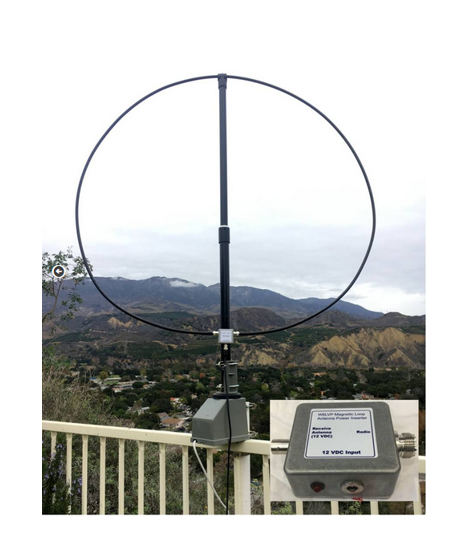
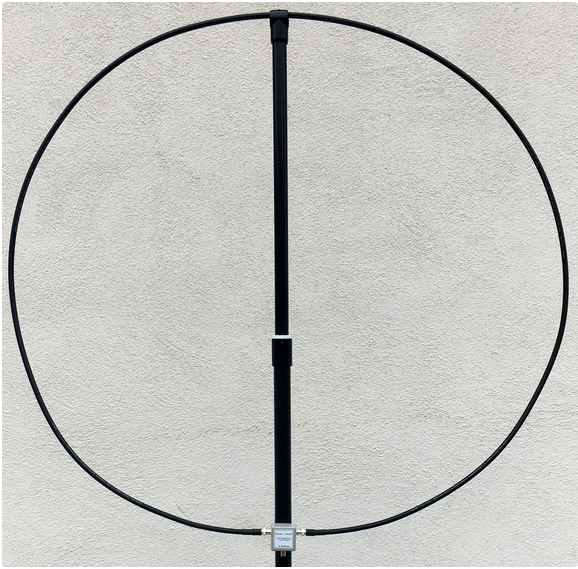

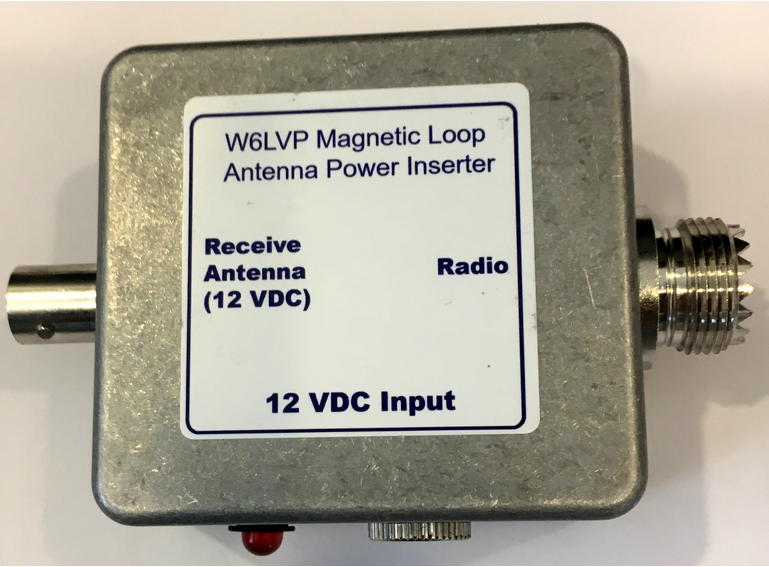
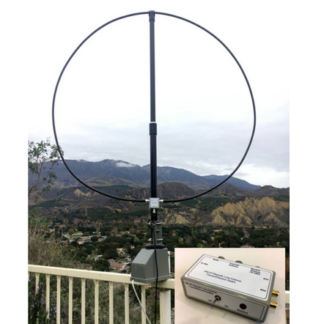
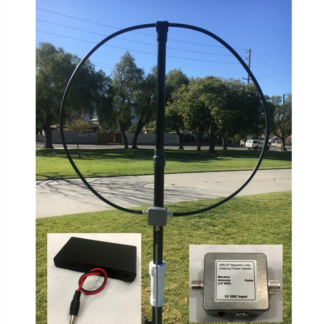
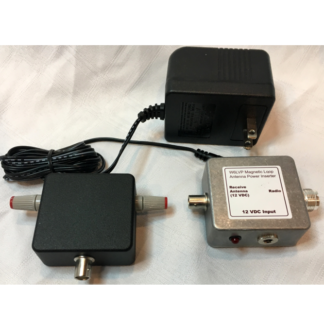

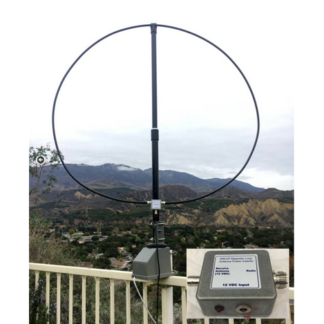
AF7NX –
Diversity with a Receiving Loop
I have tested and compared performance of the W6LVP loop against my wire antennas. The Loop does a good job especially on 40, 80, and 160m bands.
Amplified loops potentially have a problem with IMD from nearby broadcast stations. With a couple of AM stations only a mile away from me, this has been an issue with my wire antennas. The W6LVP loop I tested included an AM broadcast band HP filter which kept the broadcast band IMD mixes in check.
The vertical loop provides polarization diversity when used in conjunction with horizontal dipoles. Used with two receivers, one with the loop and one with a dipole, polarization fading on one antenna will be readable on the other.
The W6LVP loop is useful as a DF antenna for tracking down pesky RFI. The amplified antenna is sensitive and wideband, with a strong directional characteristics. I use it with an RTL-SDR dongle and laptop for quantitative walk-around RFI hunting.
AJ8S –
Easy to use, works great.
I mounted the loop 10 feet off the ground and turned it by hand for lowest noise. The provided switch box made it simple to install. I connected it between my Flex and the linear running the RF and the relay line through the switch on its way to the linear. This allows easily switching receive antennas without affecting transmit. Even without the relay line connected the unit protected the pre-amp with only 100 mw of output. I found receive quality and level the same as my much larger Wellbrook loop. When compared with my 204 foot doublet at 57 feet using WSPR on 30 and 40 meters, sometimes the doublet did better and sometimes the loop did better, particularly on low angle radiation. Below the AM band the loop left the doublet in the dust. Being able to switch receive antennas is definitely an advantage. This is an excellent broadband loop.
AE6GD –
Really helps on low bands.
I installed the loop on a low cost rotator about 10 feet off the ground. I ran the loop antenna to the aux receiver antenna input on my TS-590. The signal level from the loop is about the same as from my doublet, but the noise level is much lower. This is most evident on 160 and 80 but still helpful on 40 meters. The improved s/n ratio allows me to copy CW on 160 meters that I can’t copy with my doublet. In addition, on the low bands, the loop can be rotated to null specific noise sources. I’m planning to use the loop antenna for Field Day this year, probably on 40 and 80 CW. This is a high quality unit and it works. Very much worth the cost.
K5KWG –
Great low noise receive loop antenna.
After extensive testing with WSPR on 15 20 30 40 80 and 160 meters I found this antenna to be equal and in some cases superior to my Wellbrook low noise receive loop. The lower cost and the fact that this product includes a transmit / receive antenna switch box makes it a better choice. The switchbox allows my IC-7100 to work with either a transmit antenna for both transmit and receive or also to instantly switch so that even though my radio only has one antenna port it can be switched to use the loop for receive and my normal transmit antenna for transmit. This allows me many times to hear signals that are otherwise buried in the noise.
I love the low noise of the receive loop and the fact that it receives from 2200 meters to 10 meters without any tuning.
W9OY –
Youtube review
I replaced my Wellbrook receiving loop with Larry W6LVP’s wide band receiving loop. The Wellbrook antenna worked FB but after about a year the amplifier blew and it became problematic to get the amp working again, since the Wellbrook antenna is made in England. Larry’s antenna is good ol’ U.S. made so I knew if I had any issue I could give him a buzz out in Santa Paula (north of LA) and he’d fix me up. The loop uses a 10 ft piece of LMR-400 which makes it quite portable, and if you want to make the loop bigger just get a longer piece of LMR-400 add a couple BNC’s and you’re in business! The amp is in a nice diecast aluminum box. Larry makes a version which has built in RF switching if your radio happens to not have a separate RX input but I’m running a Flex 6700 which has multiple inputs so I opted for the version which is sans the extra relay circuit. I mounted mine on a 24ft fiberglass pole out on a part of the property away from any buildings or other antennas. I do not have a rotor on this setup, I merely rotated the antenna for least noise on 80 and 160, my primary bands of interest and put a nail in it. I tuned to a HR5 (Honduras) pileup on 80 and the antenna made a DRAMATIC difference. My noise on the vertical was -93 dBm or S5 on my calibrated Flex S meter and dropped to as low as -118 dBm or S1 a good 25 dBm! I made a youtube demo to tell the tale. Works great!
https://youtu.be/_ldP-Z3lyBY
73 W9OY
W4CLJ –
Superb Performer
I have the receive only model since my focus is on MF/LF/VLF DXing. Generally I, use a 280 ft Inverted-L for these frequencies. QRM and QRN is tough to overcome on these bands but the Loop is effective at overcoming both problems. Listening to a station on the Inverted-L can present me with one station; then switching to the loop I hear an entirely different station on the same frequency.
Noise (QRN) in the LF and VLF spectrum is very problematic on the Inverted-L but the Loop virtually eliminated the noise and lets me receive stations previously unheard. This Loop is a great addition to the shack. Larry’s communication with his customers is second to none! By the way,this antenna surpasses all others I have used for monitoring very low powered WSPR transmissions.
W9OY –
https://youtu.be/b_sHPnaJnmQ
http://sdr-w9oy.blogspot.com/2017/02/loops-w6lvp-antenna.html
This is an excellent product
W9OY –
Summary from W9OY blog.
I ran the ARRL DX CW contest for a few hours this weekend and had a great time. I recently installed a W6LVP RX loop antenna and wanted to see how it would work for the low bands., 160, 80, 40.
I added the W6LVP loop to my station last weekend, and decided to wring it out in this contest. It made a HUGE difference in what I could hear on 160 and 80 and to a lessor extent on 40. I ran the antenna exclusively on RX. The DX contest is a good test of any system and there was no overload or distortion products. My system is set up with a Flex control (aka a knob) which allows fine tuning of the radio and I run generally 70hz bandwidth on my RX so fine tuning is often necessary. There is virtually no interference. My band noise was running typically -113 dBm (S2 range) on 160M and -118 dBm (S1 range) on 80M. Without the loop band noise was up around -95 dBm or S5.
My results? I ran for a total of 412 minutes (6:52) over the 48 hour 2 day contest. In that time I managed to work 141 countries and a total of 162 contacts. I was not trying to amass the biggest score, but I wanted to see how well the antenna worked. It was fabulous! I could hear everything! I worked out EU until I was so far into their daylight (like at noon in DL on 40M I could still copy stations and at 2PM EST I was already able to work EU this afternoon. As EU faded JA and UA0 came into focus along with VK ZL KH2 Guam and half a dozen others on both 80 and 40, so conditions here were good. I have an inv-L on 160M, a vertical wire hanging out of a pine on 80M as well as a 40M 1/4 wave al over the same ground screen, about 4k feet of #14. My amp is automatically band switched by the 6700 and I have a antenna switch which switches in each bands vertical automatically so it makes contesting very easy.
I managed to increase my DXCC total by 5 countries and several band fills on each band. Operating the station was so addictive I was up till 4:30 am and eventually had to force myself to put it down. so mu butt is dragging right now. Without the loop I’m sure the noise would have worn me down hours earlier. Total score was 67,257 not bad for 412 minutes of operating time and a couple wires hanging out from a tree!
73 W9OY